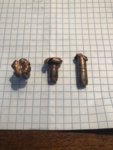Thank you. Auto-correct is a punk.
Failures in killing, or a generally misguided belief that what a bullet looks like after it does it’s job determines how well it killed?
When using a fragmenting bullet such as a Berger you have to go up in weight to maintain penetration, but what you gain is a significantly larger wound.
The hunting world’s problem, is we’ve bought wholesale into Barnes advertisements with pretty bullets after killing as a determiner of how they killed. I use Barnes. And GMX, E-Tips, etc. They are good at what they do, however what a bullet looks like at the end has little, to no bearing on how fast things die.
Impacting how? If the bonded bullets loses weight due to fragmenting on the bone, those fragments spread radially outward from the bullet path creating more damage by tearing, penetrating, crushing more tissue. Depending on the bullet, the main portion that continues to penetrate past the bone is probably as big, or even slightly bigger than most monos.
The overall thing here is monos such as the Barnes TSX/TTSX create relatively narrow wound channels, in fact the narrowest other than solids. This can be a good thing or a bad thing depending on use. But don’t buy into the belief that just because a bullet looses weight that it in inferior.



